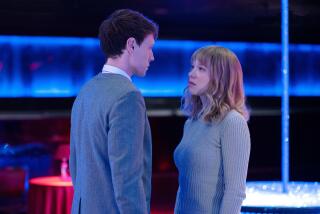Theatrical Version of ‘Beast’ a Treasure
- Share via
About a year ago, Disney/Image released “Beauty and the Beast” on laser disc in the work-print version originally previewed before the film’s 1991 opening. Disney said it was releasing the work print, not the complete film, to prevent pirates from striking sharp VHS versions from the higher quality of laser-disc sound and image--and cutting into its profits from Disney’s VHS release.
Now that Disney has sold millions of VHS copies of the film, it has released the complete theatrical version on a new CAV two-disc laser edition. No VHS tape can hold a candle to this sparkling letter-boxed picture (with rather narrow banding) in the standard-play format. The Ashman-Menken Broadway-sounding score in Dolby surround digital sound adds to the pleasure of watching the first animated film to get a best picture Oscar nomination.
But it makes one wonder where all those pirates went. Can’t this version be duplicated just as readily? Maybe Disney figures it has wrung out all the big bucks from the videotape market. A cynic might even suggest that this was a Disney ploy to get laser-disc aficionados, always eager for the definitive versions of films, including animated ones, to fork over big bucks twice--$50 for the work-print version then and $50 for the CAV version now. The complete film is also available in a $30 version, which is CLV (extended play) and doesn’t offer the advantages of precise freeze frames that add to the fun of watching animation at home.
The CAV version also comes with a pat-ourselves-on-the-back, behind-the-scenes Disney documentary: “Be Our Guest: The Making of ‘Beauty and the Beast,’ ” which takes up the fourth side of the two-disc set.
Still, “The Making of . . .” narrated by David Ogden Stiers, who also essays the voice of Cogs-worth the clock, offers enough interviews and snippets of how the film was put together, the characters and their voices conceived, to make it worthwhile. It’s a surprise to hear writer Linda Woolverton reveal how the character Chip started off as a “joke,” that she had never intended for the little cup to stay in the story. But once the rest of the creative team started thinking of the possibilities the character offered, everyone found him irresistible.
It’s delightful to hear young Bradley Michael Pierce talk about how “I sort of thought like an 8-year-old” and what an 8-year-old would say and do as Chip. Robby Benson, who has developed quite a career for himself as a voice-over actor, talks about how there was “something in Linda Woolverton’s words that is very much inside of me” that enabled him to “play” the Beast.
And it’s fascinating to finally see how Disney animators acknowledge how they utilized the computer, primarily in the ballroom dancing scene between Beauty and the Beast, providing a unique perspective that should prove enticing to students of animation.
The question for laser-disc buyers is whether the documentary, coupled with the capabilities that CAV offers, makes the additional $20 investment worthwhile over the new CLV version. The ability to freeze frame clearly and view the animation one frame at a time may tilt the balance.
The fourth volume of MGM/UA’s Looney Tunes and Merrie Melodies editions of the early Warner cartoons offers more insights into animation-cartoon history.
“The Golden Age of Looney Tunes, Vol. 4” ($100, five discs) is another cornucopia of classic and not-so-classic moments from the Warner library of the ‘30s and ‘40s. Ten sides come jam-packed with 73 cartoons, which can be watched piecemeal, as your own cartoon festival or on a double or single bill. They’re a bit overwhelming to take in all at once.
The four-page color brochure accompanying the set provides a rather comprehensive guide through the carefully put-together segments. They encompass “Bugs Bunny,” “Early Chuck Jones,” “Friz Freleng,” “Cartoon All-Stars,” “Radio Daze,” “The Frantic Forties,” “Wacky Blackouts,” “Hardaway/Dalton and Private S.N.A.F.U.,” “Sniffles” and “Merrie Melodies.”
Among the highlights are “Radio Daze” cartoons parodying the top audio and film entertainers of the day, with “Malibu Beach Party” taking on everyone from Jack Benny to Mickey Rooney and Bette Davis. The Private Snafu cartoons created by Theodor Geisel (Dr. Seuss) and designed by Chuck Jones are fascinating black-and-white curiosities intended to humorously teach our fighting men how not to behave.
The only quibble with an otherwise well-designed presentation is not naming the specific chapter stops for each cartoon listed. To sniff out “Sniffles and the Bookworm,” for example, you have to count up all the cartoons that preceded it to come up with No. 62, which would zip you there on a chapter search of Side 9.
LASERBITS
NEW MOVIES JUST OUT: “The Vanishing,” the remake starring Jeff Bridges (FoxVideo, $40, widescreen); “Married to It” (Image, $40).
COMING SOON: “Map of the Human Heart” starring Jason Scott Lee on Nov. 3 (HBO, $35); “Made in America” with Whoopi Goldberg and Ted Danson on Nov. 24 (Warner, $35); the director’s cut of “Benny & Joon,” including deleted footage (MGM/UA, Dec. 4).
OLD MOVIES JUST OUT: “The Prince and the Pauper” (MGM/UA, 1937, $40) starring Errol Flynn; “Please Don’t Eat the Daisies” (MGM/UA, 1960, $35) with Doris Day and David Niven; “Smile” (MGM/UA, 1974, $35), the Michael Ritchie-directed satire of beauty contests featuring Bruce Dern and Melanie Griffith.
More to Read
Only good movies
Get the Indie Focus newsletter, Mark Olsen's weekly guide to the world of cinema.
You may occasionally receive promotional content from the Los Angeles Times.










